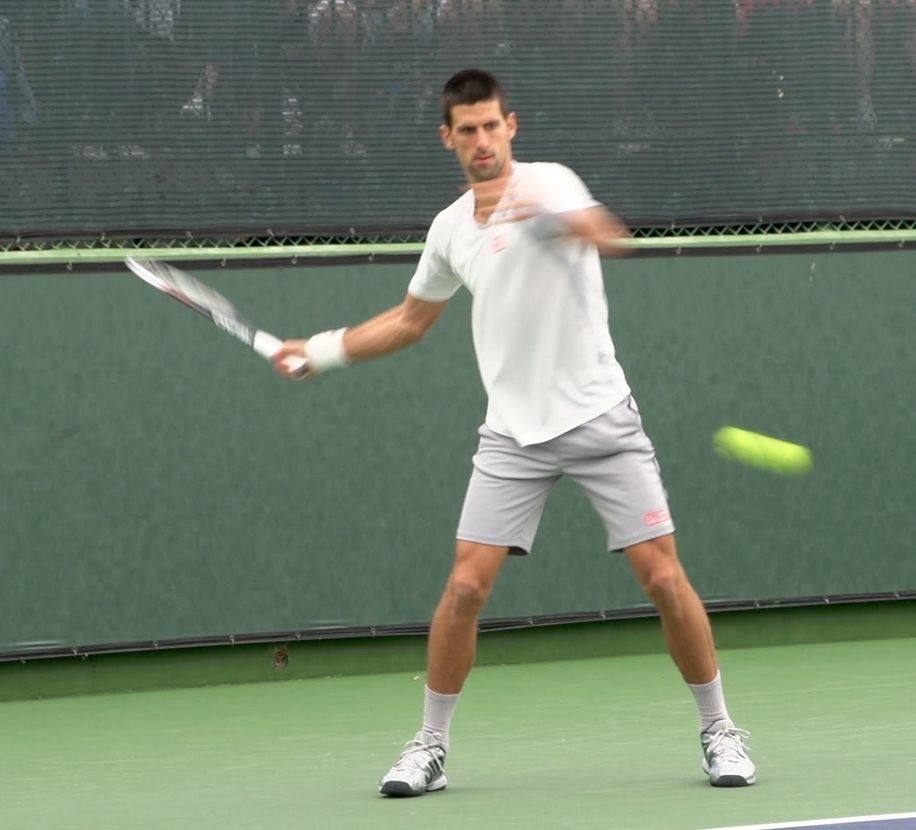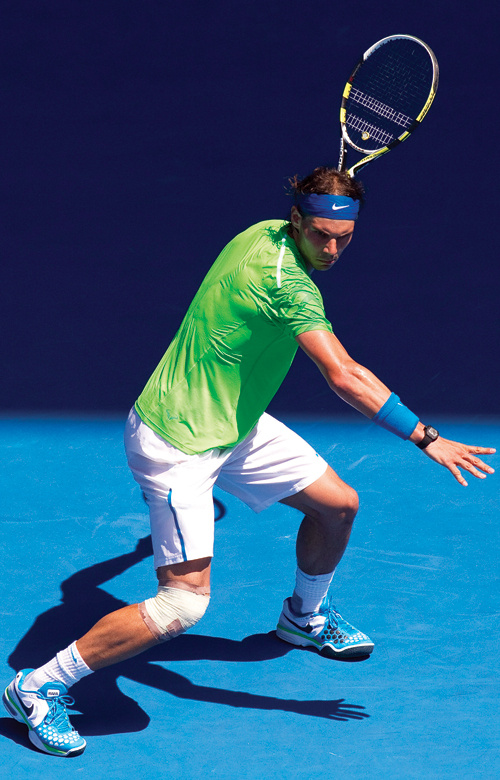THE PREPARATION / OPENING in topspin forehand
(we strongly recommend that you don’t use the opening in the first stage of learning the technique, because at the beginning you need to focus on the indishield-wiper movement of the racquet – in front of your body – and our mind, when it needs to learn something as complex as the technique of topspin, only able to learn one thing at a time <see cap. “Isolation & integration”>. Trying to learn it all together can lead to big problems – such as be unable to fine the timing to hit the ball – that can create strong frustrations that can lead the player to think about not being able to learn a technique so complex).
Here we describe several steps, but, of course, opening must be smooth, without interruption (not angular, but “circular”), in order not to lose “the run-up” accumulated by the racket.
■ the opening position





In opening the body turns to the right and the arm carries the racket back until it is perpendicular to the net. It is a fluid motion in which there are no stops that would lose “the Chase” to paddle, and then energy (see video of Djokovic below).
In this phase THE MOVEMENT OF THE RACKET is:
1) at first the racket rises at the top (the head is perpendicular to the ground).
2) then, with a curved trajectory, the racket goes back down (the head is now horizontal) – consider that more the racket is back, and the more powerful your shot will be.
3) the arm load “line an elastic” with the wrist that rotates clockwise and the head of the racket that goes even more toward the left side of the field (the buttcup goes to watch the fence right – see previous video of Djokovic).
The BODY MOVEMENT is:
1) the body rotates so that your chest go to watch the fencing of the right of the field.
2) the hip goes backward (because to give more power on the ball the hip joint should have the longest route possible to advance: this is the linear motion movement that replaces the movement of traditional shot, in which you move your weight forward without rotation of the body).
3) simultaneously legs flexs; the right leg (slightly behind the other) supports most of the body’s weight. The extension of the legs will give a movement from bottom to top that will unload on racket giving ball rotation.
At this point the shot starts by unloading the charge accumulated while you move back your weight and twist (a) the body and (b) of the right arm, and (c) with the advancement of the hip and (d) the puch of leg stretching.
Other considerations:
– the elbow moves away from your body (farther the shot starts and more “run-up” has the head of the racket, and more strength you download on the ball).
– the racket rises high into the opening.

There are some possible variants: women, sometimes muscularly less powerful than man, open the head of the racket eveno more (lead the racket over the perpendicular axis to the net, bringing the tracket more towards the left fence), thereby increasing the rotation of the body (creating an elastic body charge) and increasing the length of chease of the racket.
■ the TORSION of the torso
The topsin replaces the traditional body position perpendicular to the net with a parallel to the net stance, and motion from linear movement towards next to rotation.
In other words replacing the pure push (or almost) with the rotation.
The rotation of the torso (body is loading as an elastic) is crucial because it allows to accumulate the energy which is then unloaded on the ball and becomes the rotation of topspin.
■ the torsion of the arm
When you stretch the arm backwards, you load it with torsion (like the elastic a little airplane for kids).
This is to allow the arm to unload the force with a rotating motion that gives the racket the circular movement of windshield-wiper (often incorrectly attributed to the wrist movement).
This is to bring the head of the racket a bit more towards the left fence (while the arm does not move, but it twits), with a clockwise motion: you feel that the arm is loading (forcing the movement feels elbow hurts!).



(source blog.tennisspeed.com)
go to next page >> the START in topspin forehand
Topspin Forehand ● START